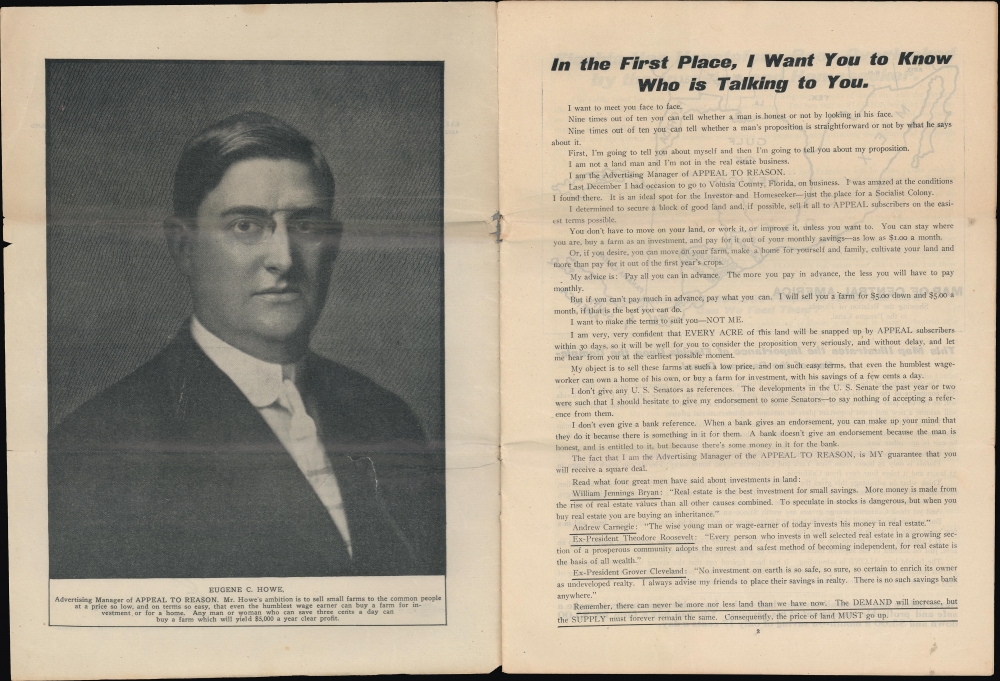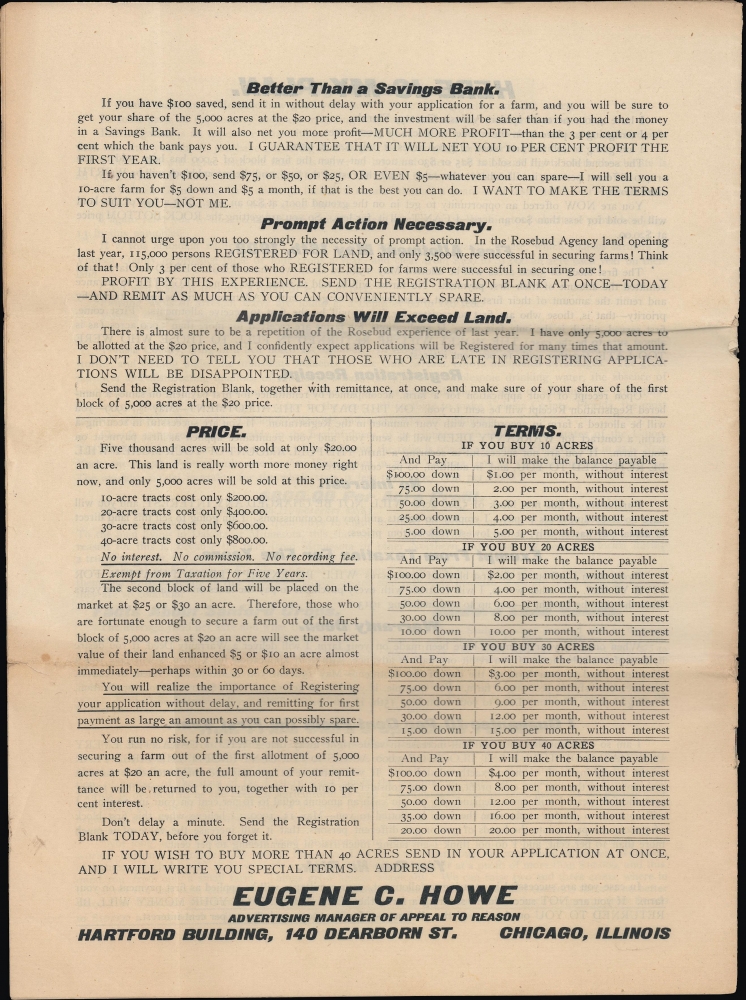This item has been sold, but you can get on the Waitlist to be notified if another example becomes available, or purchase a digital scan.
1911 Howe Promotional Real Estate Map and Booklet, Volusia County, Florida
VolusiaCoFLPromotional-howe-1909
Title
1909 (dated) 8.5 x 11 in (21.59 x 27.94 cm)
Description
A Closer Look
The main booklet, published under the header of Appeal to Reason and written by Howe, includes several maps indicating the position of the lands within Volusia County and Florida writ large. Additional maps emphasize the ease of access to Florida (by rail) from Chicago and New York, as well as the state's expected increased importance once the Panama Canal became operational (1914). Text throughout praises the affordability and availability of quality land in Florida, particularly those being sold by Howe.A Socialist Colony in Florida?
As the booklet's cover (the fifth image) makes clear, the Howe-Currier Tracts in Volusia County were originally intended to be a socialist colony. It seems odd that a socialist newspaper would be involved in patently capitalist boosterism, but this incongruence can be explained by examining the publication's origins. Howe's employer, Julius Wayland, who published Appeal to Reason, had been involved in an earlier, failed utopian socialist colony in Tennessee before he went into publishing and clearly retained an interest in similar projects. The newspaper also had early ties to the Farmers' Alliance and People's Party, rooting it in Midwestern agrarian left-wing movements.This booklet was prepared when Appeal to Reason was at the height of its popularity, with half a million subscribers (making it the largest socialist newspaper in U.S. history). It regularly published works by the likes of Upton Sinclair (including the first appearance of The Jungle), Jack London, and Eugene Debs. Howe's intentions appear to have been true to his socialist values, with land being offered to appeal to subscribers at highly favorable terms with a range of payment options to make real estate accessible even to those of modest means.
The Howe-Currier Tracts
When this booklet was prepared, Volusia County was still very sparsely populated. In 1908 or early 1909, Howe and his business partner George H. Currier bought 35,000 - 40,000 acres of land in the central part of the country from the Bond Lumber Company. The land had some advantages over some other new tracts in Florida; namely, it did not consist of swampland, the soil was suitable for farming, and it was traversed by the Florida East Coast Railway, which operated a branch line from Deland to New Smyrna (now New Smyrna Beach). Still, the land needed preparations before becoming the agricultural powerhouse Howe envisioned. In particular, drainage and irrigation works needed to be established and roads constructed; work that was completed in short order.Though Howe and Currier remained in Chicago, they had a capable local agent, Mr. M. Leidersdorf, who could show potential buyers their plots and coordinate locally. As mentioned above, the plots were initially meant to be sold only to subscribers of Appeal to Reason. However, after readers asked for exceptions for their non-subscriber family and friends, the application process was opened to all interested parties. Hitting the market at the height of the early 20th century Florida Land Boom, most of the tracts sold within months, forming the basis for the communities of Indian Springs, Alamana, and Samsula-Spruce Creek. Despite the original intention of forming a socialist colony in Florida, the Howe-Currier Tracts appear to have not attracted a disproportionate share of socialists. (For instance, the proportional vote share for Eugene Debs in Volusia County in the 1912 presidential election was slightly below average for Florida, and the same was true of Allan Benson four years later and Debs again in 1920).
Florida Land Boom(s)
In the second half of the 19th and throughout the early 20th century, Florida experienced a series of land booms and crashes. The initial land boom established Florida as a center for the citrus industry in the 1880s - 1890s, and its collapse allowed for the easy acquisition of large tracts of land at cut-rate prices. Industrialist and founder of Standard Oil Henry Flagler (1830 - 1913) seized the opportunity to build his Florida East Coast Railway and extend it to the region that would develop into Miami and other communities on the state's southeastern coast.Flagler and other Florida boosters successfully promoted the state as a paradisical escape from the grimy cities and cold weather of lands further north. Land prices shot up at an astronomical rate, and developers carved entirely new cities out of wetlands in mere months. In addition to Flagler's railway, the arrival of the highway system in the 1920s made the region more easily accessible. However, the speculation around land prices in Florida had reached irrational heights, and the damage caused by two hurricanes, followed by the financial crash of 1929, led to a collapse in the real estate market, ruining many investors in the process.
Publication History and Census
This booklet was prepared by Eugene C. Howe and printed by the Allied Printing Trades Council for distribution to subscribers of Appeal to Reason. The booklet is undated but refers to an upcoming allotment of land on May 15, 1909, suggesting a date of early 1909. The last image above displays associated documents, including a Howe and Currier selling guide for agents (dated 1911) and a 1913 letter that accompanied a deed for Mrs. Anna Spencer of Rockford, Illinois. We have been unable to locate any other examples of the promotional booklet or selling agents' booklet in institutional collections or on the market.CartographerS
Eugene C. Howe (May 26, 1866 - July 11, 1932) was a Chicago-based advertising manager, publisher, and real estate promoter who worked for the left-wing newspaper Appeal to Reason. He was born in Michigan and worked independently as well as with Appeal to Reason (which was based in Kansas) over the course of his career. With a business partner, he operated 'Howe and Currier' promoting land in Volusia County, Florida, during the Florida Land Boom. More by this mapmaker...
Allied Printing Trades Association (c. 1893 - present) is a grouping of trade unions for printers, bookbinders, engravers, and associated trades. It was formed through a combination of five existing unions, the largest of which was the International Typographical Union (which had started as the National Typographical Union in 1852). Though not fully formed until 1910 - 1912, the name and insignia of the Allied Printing Trades Association had been used by local chapters of the International Typographical Union since 1893. The association became known for its 'bug' insignia, which would be displayed on newspapers and other publications which its members printed. It still operates today, with representatives in over 500 printshops and similar businesses throughout the U.S. Learn More...


















